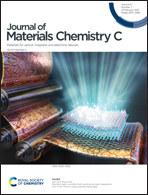MD simulation study on defect evolution and doping efficiency of p-type doping of 3C-SiC by Al ion implantation with subsequent annealing†
Abstract
We use molecular dynamics (MD) simulation with numerical characterisation and statistical analysis to study the mechanisms of damage evolution and p-type doping efficiency by aluminum (Al) ion implantation into 3C silicon carbide (SiC) with subsequent annealing. By incorporating the electronic stopping power for implantation, a more accurate description of the atomic-scale mechanisms of damage evolution and distribution in SiC can be obtained. The simulation results show a novel observation that the recrystallization process occurs in the region below the subsurface layer, and develops from amorphous–crystalline interface to the damage center region, which is a new insight into previously published studies. During surface recrystallization, significant compressive stress concentration occurs, and more structural phase transition atoms and dislocations formed at the damage-rich-crystalline interface. Another point of interest is that for low-dose implantation, more implantation-induced defects hamper the doping efficiency. Correspondingly, the correlation between lattice damage and doping efficiency becomes weaker as the implant dose increases under the same annealing conditions. Our simulation also predicts that annealing after high temperature (HT) implantation is more likely to lead to the formation of carbon vacancies (VC).



 Please wait while we load your content...
Please wait while we load your content...